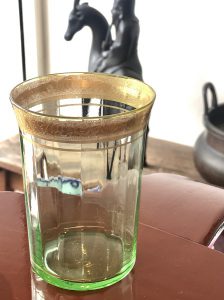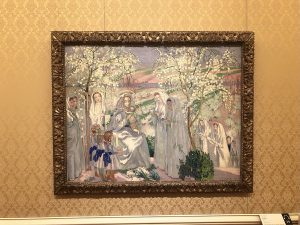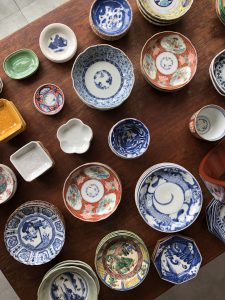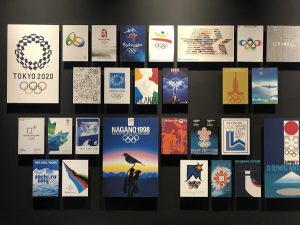みなさま、こんにちは。スタッフYです。

先程ランチタイムに、ちょうどスプーンを使っていたのですが、まあ普通に何も考えずに使っておりましたよ。
そのスプーンについてなんですが、なんとも興味深いニュースがありましたので、今日は、そのお話を少し。
イギリスでは車のトランクに不用品を入れて公園などで販売する「カー・ブート・セール」なるものがあるのですが、そこは、様々なものが格安で売られているのフリーマーケットといったところでしょうか。販売者にとってはただのガラクタに過ぎないかもしれないのですが、時にとんでもないお宝が眠っていることもあるらしいのですが。
先日、そのカー・ブート・セールにて、今回20円で売られていた1本のスプーンの価値に気付いた男性がそれをオークションに出品すると、なんと29万円で落札されたという、なんとも夢のあるニュースがアップされていました。いったいこのスプーンにどんな価値があったのでしょうか。
英ロンドン市内のカー・ブート・セールで販売されておりましたそのスプーン、酸化したせいか黒ずみ、表面は凸凹の状態。さらに全体的に捻じれてしまっており、“スプーン”と呼ぶにはあまりにも不格好なものだったようです。モダンなカトラリーと一緒に販売されておりましたが、その中でも古さがひと際目立っていたといいます。名前を明かしていない発見者の男性はこの20ペンス(約20円)で販売されていたスプーンを一目見て、「これは儲かるぞ」とすぐにその価値に気付いたそうだ。
ここで、気になることが。この落札価格も気になりますが、何故その価値に気づいたのでしょうか。発見者の男性、カトラリーの歴史にも精通していたのか、ただの直感なのか。古美術店スタッフとして、まずはそちらの方に興味がわいてきました。ですが、その辺りは明らかになっていないようで、そちらの情報をその男性にインタビューしてみたいところですね。
早速男性は、このスプーンを購入した後、サマセット州クルーカーンにあるオークション会社「Lawrences Auctioneers」に連絡し、鑑定を依頼したそうで、鑑定を担当した銀の専門家アレックス・ブッチャーさん(Alex Butcher)は、このスプーンが13世紀後半に作られたものであると明かし、控えめに考えても500ポンド(約76000円)の価値があると見積もっております。
この時点で購入価格を大きく上回る驚きの金額が提示され、発見者の男性はオークションに出品することを決めます。そして競売当日、アレックスさんの予想をはるかに超えた激しい競り合いが起こり、価格はどんどん吊り上がり、20ペンスで買ったスプーンは1900ポンド(約29万円)という衝撃の価格で落札されたではないですか。最終的には手数料などを加え、落札者は2375ポンド(約36万2000円)を支払ったそうです。
長さ5インチ(約12.7センチ)、重さ0.35オンス(約9.9グラム)の小さなこのスプーンには先端にどんぐり型の装飾が施され、持ち手の部分が4面構造になっている特徴を持ち、これはローマ時代以降のヨーロッパで最古のスタイルであるということです。
今回のスプーンと同様の特徴を持つスプーンが2013年、別のオークション会社で競売にかけられていたらしいのですが、こちらは1300年代前半にイングランドの王として在位していたエドワード2世が所持していたとされるスプーンで、22500ポンド(約340万円)で落札されております。川底で発見されたというこちらのスプーンの写真を見ると、今回のスプーンよりも状態が良いことは一目瞭然。
競売人は今回のスプーンを「ダメージがあり、歪んでいる」と商品状態として説明したそうだが、それでも高額だったことはそれなりの価値があるようです。
鑑定したアレックスさんは「このスプーンは何世紀もの間、地中や川底で眠っていた状態と一致します」と明かしています。また「発見者の男性は銀製品の販売業者ではなく、趣味でカー・ブート・セールを訪れているそうですが、良い目を持っていますよね」と男性の持ち前のセンスを称賛したそう。またまたそこですよ。いや、なんで気づいたの、そんな古い年代物と。どうして、その価値がわかったのか、先ほどから気になるのは、そこですよね。
続けて「発見した男性は『娘と一緒にオンラインオークションの様子を見守っていて、とても信じられない』とメールをくれました。私もこの結果には大満足です。素晴らしいロマンチックなストーリーですよね」と喜びを明かしております。
ちなみに発見者の男性は、このスプーンの売上金でイングランド東部にて優雅な休暇を過ごすことを計画しているとか。
たかがスプーン、されどスプーンでしたね。
ところでカトラリー。その歴史は意外と浅いのです。今から考えるとおよそ200年前。日本で言うと、江戸時代のころでしょうか。
じゃあカトラリーが普及する前は、どうやって食べていたの?というのが気になるところですが、もちろんあれです。
驚くべきことに、実は「手」を使っていたようです。それと同時にマナーもあまり洗練されていなかったみたいで、昨今の欧米のテーブルマナーを思うと、信じられませんね。
ではなぜ「手」を使っていたか、それは一概に「道具がなかったから」とは言えないようして。
手づかみ食事スタイルの裏にあるのは、「指は神様が与えた優れた道具である」という宗教観からきているようで、食事に触れられるのは自分の手指だけ、というような教えが根本にあったのだと考えられます。
また、マナーの教本のようなものができたのは13世紀ごろ。それまでは、今では考えられないほど食事のマナーは悪かったようです。
太古からスプーンのような形状のものは発掘されてはいますが、食事に用いられていたわけではなく、調理や化粧道具として用いられていたようで、食事に登場したのは14、15世紀ごろ。スープを飲むために使われましたようです。しかし、これは上流階級での話。スプーンは当時、高級品だったため、一般庶民には普及していませんでした。庶民がスプーンを使うようになるのは17~18世紀ごろにまで下るようです。
ちなみにスプーンはキリスト教と深いかかわりを持ちます。それは洗礼式の場面。
キリスト教徒は子どもが生まれると、洗礼を受けさせます。その時に、スプーンを贈る、という習慣がありますよね。
その素材は貧富の差によって変わり、裕福な家では銀のスプーンが贈られました。
このことから、「銀の匙をもって生まれてきた子は幸福になれる」という言い回しができたようですね。
また、ナイフやスプーンのように、すんなりと人々に受け入れられなかったのが、フォークでした。今では、フォークがなければお肉食べられないじゃないか、と思ってしまいそうですが、中世ヨーロッパでは、手で食べないなんて!という認識だったようです。熱いものどうやっていただいていたのでしょうか笑。
ですが、西欧で食卓にフォークが上ったのは、意外に早く、11世紀のイタリアでのことだったそうです。
しかし、そこからが長かったようで、根本にあるのは、「食べ物は神様からの授かりものであるから、手で食べるのが正当である。フォークを使うのは摂理に反する。」という宗教の教えでして、人々に根付いたこの考え方を変えるのには、長い時間がかかったということですね。
しかも、フランスにフォークが登場したのは16世紀ごろですが、浸透せず、また手づかみスタイルに逆戻り。
原因はフォークの形にもありました。そのころのフォークは今とは違って、二股で使いづらいものでした。
そのため、貴族が気取って、大変そうにフォークで食べる様子は、庶民からすると嘲笑の対象にもなったようで、どの時代も先駆者たちは数奇な目でみられるものなのか笑。
ですが、イタリアではパスタを食べる習慣のために、16世紀という比較的早い時期から普及しましたようです。ところが、イギリスでは18世紀に入るまでは使用されずと、このように、各国でも広がり方に差がみられるようですね。
実は、そのカトラリーの中でも最も早く、12世紀ごろテーブルに登場してきたのはナイフ。
とは言っても、現在のように個人用として置かれているのではなく、大きな肉を切り分けるためのナイフがテーブルに一本だけ用意されていたようでして、その後、15~16世紀になると、ようやく一人一人がナイフを使うようになります。
ですが、こちらも今のように招く側が用意するのではなく、個人がナイフを用意し、持参する形だったようです。Myナイフ持参でしたか…。
当初、ナイフの先は尖っていたため、食事の後にナイフの先で歯の掃除をする人も多かったそう。(Myナイフだからでしょうか焦)
とまあ意外にも、カトラリーが一般的になるまでにはかなりの時間がかかったようですね。
では、それを使ったマナーという考え方はどのように始まったのでしょうか。
13世紀ごろに出版された初期のマナー本の内容は「テーブルの上や周囲に唾を吐いてはならない」など、今となってはマナーと言うよりはルールに近いものでした。
14世紀に入ると「食事前には手を洗うこと」など、基本中の基本のマナーとなっていきます。そして、15世紀、フランス王家に嫁いだカトリーヌに付き添ってきたイタリア人シェフが著した『食事作法の50則』。これが最初のテーブルマナーの専門書となりました。
このようにして、テーブルマナーは世界に広がっていくことになるようです。
今となっては、マナーというのは各国各地、時代によって変化するもので、あくまでもみんなで食事を楽しみ、周囲を不快にさせないためのもの。とはいえ、あまりにもマナーを気にしすぎると、料理もおいしく食べることも事実。基本的なマナーを身に着けて、食事を楽しみたいものですね。
というわけでして、たかがスプーン、されどスプーン。スプーンもいろいろな歴史を経て、ここまでに至り、私たちとランチタイムをご一緒していわけなんですね。
今日は、手に取ったスプーンを眺めながら、受け継がれている歴史を思い返しつつ、ランチをいただきたいと思っております。

Hello everyone. This is Staff Y.
I usually work by looking at old things, but I was curious about some interesting news.
In the UK, the “Car Boot Sale” is a car boot sale that puts unnecessary items in the trunk of a car and sells them in parks. Various things are sold at a bargain price there, but for the seller it may be just a junk, but sometimes a ridiculous treasure is sleeping.
At the car boot sale, when a man who noticed the value of one spoon sold for 20 yen this time put it up for auction, there was a dream news that it was sold for 290,000 yen. .. What was the value of this spoon? “Mirror” etc. tells the details.
The spoon, which has been attracting attention this time, was sold at a car boot sale in London, England. It is darkened probably because of oxidation, and the surface is uneven. Furthermore, it was twisted as a whole, and it seemed that it was too clunky to call it a “spoon”, and it was sold with modern cutlery, but the oldness stands out among them. It is said that it was. The discoverer, who did not reveal his name, saw the spoon sold for 20 pence (about 20 yen) at a glance and immediately realized its value, saying, “This is profitable.”
Yes. Here, the point to be worried about. I’m curious about this winning bid, but why did I realize its value? Was he familiar with the history of the discoverer, Cutlery, or was it just an intuition? As an antique art store staff, that person will be the first to get caught. It seems that the area is not clear, so I am very worried.
After purchasing this spoon, the man immediately contacted the auction company “Lawrences Auctioneers” in Crewkerne, Somerset, and asked for an appraisal.
The appraisal silver expert Alex Butcher revealed that the spoon was made in the late 13th century and is worth £ 500 to say the least. I estimate that.
At this point, a surprising amount of money is offered, well above the purchase price, and the discoverer man decides to put it up for auction. And on the day of the auction, there was a fierce competition that far exceeded Alex’s expectations, the price was rising steadily, and the spoon bought at 20 pence was not sold at a shocking price of 1900 pounds (about 290,000 yen). mosquito. In the end, the winning bidder paid £ 2,375 (about 362,000 yen), including fees.
With a length of 5 inches and a weight of 0.35 ounces, this small spoon features an acorn-shaped decoration at the tip and a four-sided handle. , This is said to be the oldest style in Europe since Roman times. No, why did you notice that it was such an old vintage?
A spoon with similar characteristics to this spoon was auctioned at another auction company in 2013, but it was owned by Edward II, who reigned as King of England in the early 1300s. The spoon is sold for 22500 pounds (about 3.4 million yen). Looking at the picture of this spoon that was found at the bottom of the river, it is obvious that it is in better condition than this spoon.
The auctioneer described the spoon as “damaged and distorted” as a commercial condition, but the high price seems to be worth it.
“This spoon matches the state of sleeping in the ground and on the riverbed for centuries,” said Alex, who appraised. He also praised the man’s sense of possession, saying, “The discoverer’s man is not a silver product dealer, but he visits car boot sales as a hobby, but he has good eyes.” It’s there again. That’s where everyone wonders why they realized its value.
He went on to say, “The man I found sent me an email saying,’I’m watching the online auction with my daughter and I can’t believe it.’ I’m very happy with the result. It’s a wonderful romantic story, isn’t it?” I am revealing my joy.
By the way, the discoverer’s man plans to spend an elegant vacation in eastern England with the proceeds of this spoon. It’s just a spoon, but it’s a spoon.
By the way, cutlery. Its history is surprisingly short. Thinking from now on, it was about 200 years ago. In Japan, it was around the Edo period.
So how did you eat it before cutlery became popular? I’m curious about that, but of course that is it.
Surprisingly, it seems that he was actually using his “hands”. At the same time, it seems that the manners were not very sophisticated, so I can’t believe it when I think of the recent Western table manners.
So why did you use your “hands”? It seems that you cannot say “because you didn’t have the tools”.
Behind the hand-held eating style seems to come from the religious view that “fingers are an excellent tool given by God”, and the basic teaching is that only your fingers can touch the meal. It is probable that it was there.
Also, it was around the 13th century that something like a manners textbook was created. Until then, the manners of eating seemed to be unthinkable now.
Spoon-shaped objects have been excavated since ancient times, but they were not used for meals, but seemed to have been used for cooking and makeup tools. They first appeared in meals around the 14th and 15th centuries. It seems that it was used to drink soup. However, this is still a story of the upper class. Spoons were a luxury item at the time, so they were not popular with the general public. It seems that the common people started using spoons until around the 17th and 18th centuries.
By the way, Spoon has a deep connection with Christianity. It’s a baptismal scene.
Christians are baptized when they have children. At that time, you have a habit of giving a spoon.
The material depends on the difference between rich and poor, and in wealthy homes silver spoons were given.
From this, it is said that the phrase “a child born with a silver spoon can be happy” was made.
Also, like knives and spoons, forks were not easily accepted by people. Nowadays, it’s normal to think that you can’t eat without a fork, but in medieval Europe, you can’t eat by hand! It was the recognition. I wonder how you got the hot ones lol.
However, it was surprisingly early that the fork came up on the table in Western Europe in Italy in the 11th century.
But it was a long time from there. At the root of this idea is the religion’s teaching that “food is a gift from God, so it is justified to eat it by hand. It is against providence to use a fork.” It took a long time to change.
Forks first appeared in France around the 16th century, but they did not penetrate and reverted to the hand-held style.
The cause was also in the shape of the fork. At that time, forks were bifurcated and difficult to use, unlike now.
Therefore, it seems that the appearance of the aristocrats pretending to eat with a fork was a target of ridicule from the common people.
Due to the habit of eating pasta in Italy, it became popular from a relatively early 16th century, but in England it was not used until the 18th century, and there are differences in how it spreads in each country.
In fact, the earliest cutlery that appeared on the table around the 12th century was the knife.
That said, it seems that there was only one knife on the table to cut large pieces of meat, rather than being placed for personal use as it is today, and then in the 15th and 16th centuries. At last, each person will use a knife.
However, it seems that this was also a form in which the individual prepared and brought a knife, instead of preparing it by the inviting party as it is now.
At first, the tip of the knife was sharp, so many people cleaned their teeth with the tip of the knife after eating. (You must be kidding!)
Well, it took a long time for cutlery to become popular, but how did the idea of manners begin? The content of early etiquette books published around the 13th century was more like rules than etiquette, such as “Don’t spit on or around the table.”
In the 14th century, it became a basic etiquette such as “wash your hands before meals”. Then, in the 15th century, “50 Rules of Dietary Practice” written by an Italian chef who accompanied Catherine, who married the French royal family. This became the first specialized book on table manners.
In this way, table manners will spread throughout the world.
Nowadays, etiquette changes with each country and time, so that everyone can enjoy their meals and not make others uncomfortable. However, if you care too much about etiquette, you will not be able to eat delicious food, but you want to learn basic etiquette and enjoy your meal. And when you eat with a spoon relaxedly, please remember a little about the history of the spoon.
**********************
生活様式の変化とともに、大切なお品を整理されている方も多いことと思われます。
ここ風光舎では、古美術品や骨董品の他にも絵画や宝石、趣味のお品など様々なジャンルのものを買受しております。
お片付けをされていて、こういうものでもいいのかしらと迷われているものでも、どうぞお気軽にご相談下さいませ。
風光舎は、出張買取も強化しております。
愛知県内はもちろん、岐阜県・三重県その他の県へも出張いたします。
どんなにご近所の方でもお伺いできますので、まずはお電話お待ちしております。
誠に勝手ながら、8月9日~16日まで、夏季休業とさせていただきます。
なお、電話での問い合わせは、随時承っておりますので、お気軽にご相談等ご連絡くださいませ。
愛知県名古屋市千種区・骨董 買取
『古美術 風光舎 名古屋店』
TEL 052(734)8444
10:00-17:00 OPEN



























